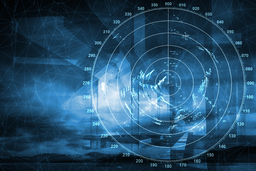High-Resolution 4-D Millimeter-Wave Imaging Radar
TECHNOLOGY NUMBER: 2021-437

OVERVIEW
A very high-resolution imaging radar composed of a stationary feed, main reflector, and rotating sub-reflector- Provides a circular array that can achieve angular resolution far less than one degree
- Generates 4-D images that are accurate, consistent, and which can be used with high-speed SAR
BACKGROUND
Imaging radar technology is a type of remote sensing technology that uses radar pulses to create high-resolution images of a surface. The technology works by emitting a radar signal towards a surface and then measuring the time it takes for the signal to bounce back to the sensor. By analyzing the properties of the returned signal, such as its amplitude, frequency, and polarization, imaging radar can create detailed images of stationary objects, such as the Earth's surface, with resolutions ranging from a few meters to a few centimeters. Beam scanning or synthetic aperture radar are the most common technologies used in imaging radars. Beam scanning involves electronic beam steering or mechanical moving of an antenna, though this approach has a limited angle resolution of only 1-2 degrees. Synthetic aperture radar (SAR) can provide high resolution two-dimensional (2D) images for stationary targets, which is accomplished by moving the radar platform at a constant speed. SAR can be therefore be limited when utilized for stationary radar or for capturing targets with an unknown path or velocity. So, a need exists for a high-resolution radar that mitigates the limitations of existing technologies.
INNOVATION
Researchers have developed a very high-resolution imaging radar which employs a special antenna composed of a stationary feed, a main reflector, and a rotating sub-reflector. This technology provides a 3D image by utilizing a main reflector and sub-reflector to achieve high resolution in azimuth (the horizontal angle of a compass bearing) and elevation. The mechanism focuses the image from the feed through sub-reflector onto the electrically large main reflector, and then it is moved around as the sub-reflector rotates. The design provides a complete rotation that can form a large, synthetic circular array which can achieve smaller than fraction of a degree angular resolution. The invention can generate 4-D radar images that define azimuth, elevation, range, and speed. Simulations and analysis of the technology have confirmed accurate and consistent results that can be used with high-speed SAR.